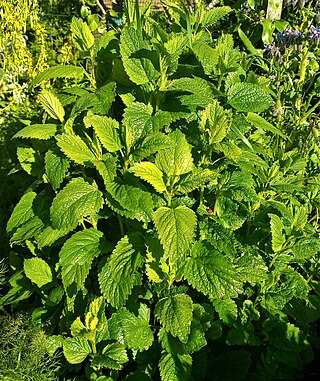
Lemon balm is a perennial herbaceous plant in the mint family and native to south-central Europe, the Mediterranean Basin, Iran, and Central Asia, but now naturalised elsewhere.
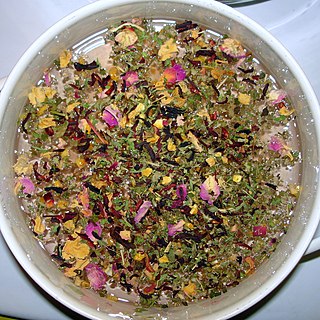
Herbal teas, also known as herbal infusions and less commonly called tisanes, are beverages made from the infusion or decoction of herbs, spices, or other plant material in hot water; they do not usually contain any true tea. Often herb tea, or the plain term tea, is used as a reference to all sorts of herbal teas. Many herbs used in teas/tisanes are also used in herbal medicine. Some herbal blends contain true tea.

Malaysian cuisine consists of cooking traditions and practices found in Malaysia, and reflects the multi-ethnic makeup of its population. The vast majority of Malaysia's population can roughly be divided among three major ethnic groups: Malays, Chinese and Indians. The remainder consists of the indigenous peoples of Sabah and Sarawak in East Malaysia, the Orang Asli of Peninsular Malaysia, the Peranakan and Eurasian creole communities, as well as a significant number of foreign workers and expatriates.

Nasi lemak is a dish originating in Malay cuisine that consists of fragrant rice cooked in coconut milk and pandan leaf. It is commonly found in Malaysia, where it is considered as the national dish. It is also a native dish in neighbouring areas with significant ethnic Malay populations such as Singapore and Southern Thailand. In Indonesia, it can be found in several parts of Sumatra, especially the Malay regions of Riau, Riau Islands and Medan. It is considered an essential dish for a typical Malay-style breakfast. Nasi lemak is featured as a national dish in most of the country's tourism brochures and promotional materials.

Malay cuisine is the traditional food of the ethnic Malays of Southeast Asia, residing in modern-day Malaysia, Indonesia, Singapore, Brunei, Southern Thailand and the Philippines as well as Cocos Islands, Christmas Island, Sri Lanka and South Africa.
In early ayurvedic medicine, rasāyana is one of the eight areas of medicine in Sanskrit literature. In Vedic alchemy, "rasa" also means "metal" or "a mineral".

Eurycoma longifolia is a flowering plant in the family Simaroubaceae. It is native to Indochina and Indonesia, but has also been found in the Philippines. The plant is a medium-sized slender shrub that can reach 10 m (33 ft) in height, and is often unbranched. The root of the plant has been used in folk medicine of the South East Asian region, and in modern times has common use as supplements, as well as food and drink additives.

Peranakan cuisine or Nyonya cuisine comes from the Peranakans, descendants of early Chinese migrants who settled in Penang, Malacca, Singapore and Indonesia, inter-marrying with local Malays. In Baba Malay, a female Peranakan is known as a nonya, and a male Peranakan is known as a baba. The cuisine combines Chinese, Malay, Javanese, South Indian, and other influences.
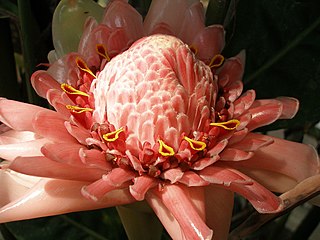
Etlingera elatior is a species of herbaceous perennial plant in the family Zingiberaceae; it is native to Indonesia, Thailand, Malaysia and New Guinea.
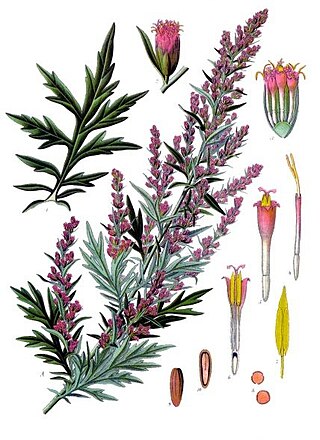
Mugwort is a common name for several species of aromatic flowering plants in the genus Artemisia. In Europe, mugwort most often refers to the species Artemisia vulgaris, or common mugwort. In East Asia the species Artemisia argyi is often called "Chinese mugwort" in the context of traditional Chinese medicine, Ngai Chou in Cantonese or àicǎo (艾草) in Mandarin. Artemisia princeps is a mugwort known in Korea as ssuk (쑥) and in Japan as yomogi (ヨモギ). While other species are sometimes referred to by more specific common names, they may be called simply "mugwort" in many contexts.

Jamu is a traditional medicine from Indonesia. It is predominantly a herbal medicine made from natural materials, such as roots, bark, flowers, seeds, leaves and fruits. Materials acquired from animals, such as honey, royal jelly, milk and native chicken eggs are often used as well.
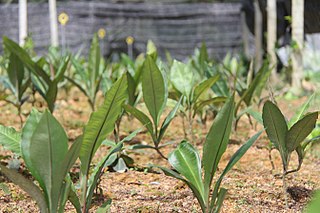
Labisia pumila is a flowering plant in the family Primulaceae native to Malaysia. It is a small, woody and leafy plant with leaves of 20 cm (7.9 in) in length, and grows widely in the shade of the tropical forest floor. The plant is popular in the traditional medicine of the Malaysian and Indonesian community, in which it is believed to be the female version of the equally well-known tongkat Ali, i.e. Ali's walking stick.
Yorùbá medicine, or egbòogi, is an Yoruba system of herbalism practiced primarily in West Africa and the Caribbean.

Cosmos caudatus or king's salad is an annual plant in the genus Cosmos, bearing purple, pink, or white ray florets. It is native to Latin America, and the West Indies, though naturalized in tropical parts of Asia, Africa, and Australia.

In general use, herbs are a widely distributed and widespread group of plants, excluding vegetables and other plants consumed for macronutrients, with savory or aromatic properties that are used for flavoring and garnishing food, for medicinal purposes, or for fragrances. Culinary use typically distinguishes herbs from spices. Herbs generally refers to the leafy green or flowering parts of a plant, while spices are usually dried and produced from other parts of the plant, including seeds, bark, roots and fruits.

Brazilian tea culture has its origins in the infused beverages, or chás, made by the indigenous cultures of the Amazon and the Río de la Plata basins. It has evolved since the Portuguese colonial period to include imported varieties and tea-drinking customs.
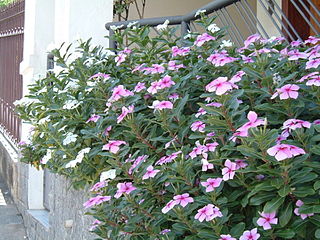
Dominican tea culture combines many customs adapted from various colonial and immigrant cultures that have mingled in Dominica. "Bush teas", made from local herbal plants and often taken for medicinal purposes, are a traditional part of Dominica's culture.

Simpang Durian is a small town in Jelebu District, Negeri Sembilan, Malaysia. It is situated about 10 km from the Pahang border and about 130 km from Kuala Lumpur. Simpang Durian is also a popular stopover destination for super bikers from Singapore and southern states of West Malaysia to rest and refuel before proceeding to Genting Highlands.
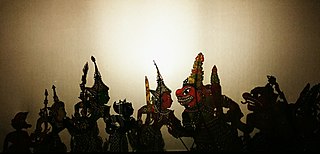
Malaysian folklore is the folk culture of Malaysia and other indigenous people of the Malay Archipelago as expressed in its oral traditions, written manuscripts and local wisdoms. Malaysian folklores were traditionally transmitted orally in the absence of writing systems. Oral tradition thrived among the Malays, but continues to survive among Orang Asli and numerous Bornean ethnic groups in Sarawak and Sabah. Nevertheless, Malaysian folklores are closely connected with classical Malay folklore of the region. Even though, Malay folklore tends to have a regional background, with the passing of time, and through the influence of the modern media, large parts of regional Malay folklore have become interwoven with the wider popular Malaysian folklore.

Traditional Malaysian art is primarily composed of Malay art and Bornean art, is very similar with the other styles from Southeast Asia, such as Bruneian, Indonesian and Singaporean. Art has a long tradition in Malaysia, with Malay art that dating back to the Malay sultanates, has always been influenced by Chinese, Indian and Islamic arts, and also present, due to large population of Chinese and Indian in today's Malaysian demographics.

















